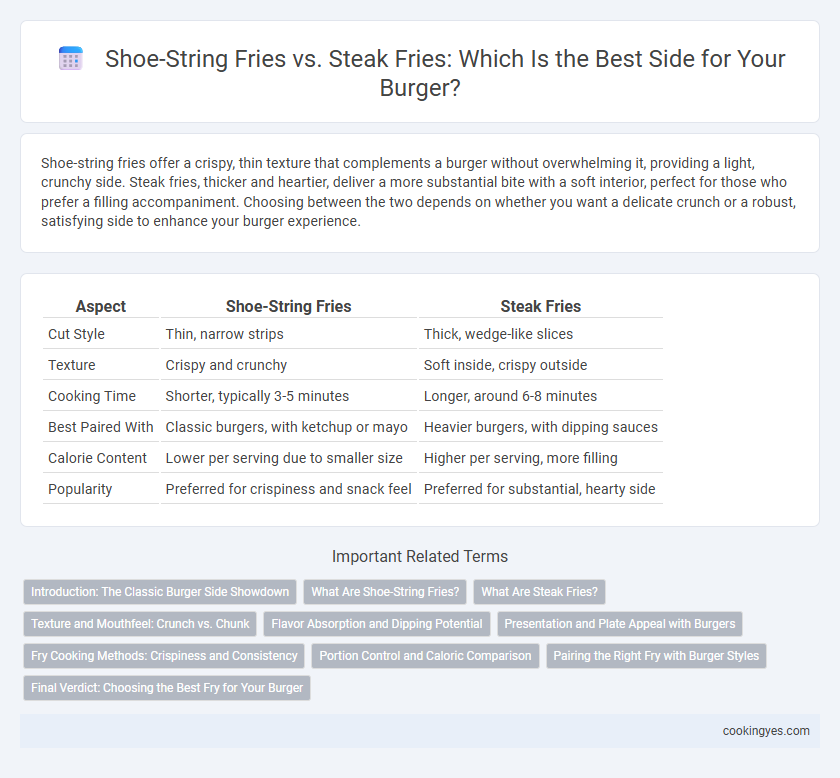Shoe-string fries offer a crispy, thin texture that complements a burger without overwhelming it, providing a light, crunchy side. Steak fries, thicker and heartier, deliver a more substantial bite with a soft interior, perfect for those who prefer a filling accompaniment. Choosing between the two depends on whether you want a delicate crunch or a robust, satisfying side to enhance your burger experience.
Table of Comparison
| Aspect | Shoe-String Fries | Steak Fries |
|---|---|---|
| Cut Style | Thin, narrow strips | Thick, wedge-like slices |
| Texture | Crispy and crunchy | Soft inside, crispy outside |
| Cooking Time | Shorter, typically 3-5 minutes | Longer, around 6-8 minutes |
| Best Paired With | Classic burgers, with ketchup or mayo | Heavier burgers, with dipping sauces |
| Calorie Content | Lower per serving due to smaller size | Higher per serving, more filling |
| Popularity | Preferred for crispiness and snack feel | Preferred for substantial, hearty side |
Introduction: The Classic Burger Side Showdown
Shoe-string fries offer a crispy, thin texture that complements the juicy flavors of a classic burger by providing a light and crunchy contrast. Steak fries, known for their thick, hearty cuts and fluffy interiors, deliver a more robust and satisfying side experience that pairs well with thicker burger patties. Choosing between these two popular options depends on texture preference and desired flavor balance in the overall meal.
What Are Shoe-String Fries?
Shoe-string fries are thinly cut, crispy potato strips that provide a light, crunchy texture complementing juicy burgers. Compared to the thicker, hearty steak fries, shoe-string fries offer a delicate bite that enhances the overall burger experience without overpowering the main dish. Their slender shape allows for a greater surface area, resulting in a satisfying crispness that pairs well with classic burger toppings and sauces.
What Are Steak Fries?
Steak fries are thick-cut potato slices with a crispy outer layer and a fluffy interior, making them a hearty side option for burgers. Unlike shoe-string fries, which are thin and crunchy, steak fries offer a more substantial bite and hold up better to dipping sauces. Their larger size and soft texture complement the savory richness of burgers, enhancing the overall meal experience.
Texture and Mouthfeel: Crunch vs. Chunk
Shoe-string fries deliver a crisp, crunchy texture that contrasts sharply with the soft, tender interior, enhancing the overall burger experience. Steak fries offer a thick, chunky bite with a fluffy center that complements the burger's hearty profile. The choice between shoe-string and steak fries depends on whether you prefer a light crunch or a satisfyingly dense mouthfeel alongside your burger.
Flavor Absorption and Dipping Potential
Shoe-string fries offer a crispy texture that maximizes flavor absorption, ideal for capturing the rich, savory tastes of burger sauces and dips. Their thin, crunchy design allows for quick soaking of condiments, enhancing every bite with balanced seasoning. Steak fries, with their thicker cut and denser interior, provide substantial dipping potential but absorb flavors more slowly, delivering a hearty complement that pairs well with robust burger toppings.
Presentation and Plate Appeal with Burgers
Shoe-string fries offer a crisp, golden texture that creates a visually appealing contrast when paired with juicy burgers, enhancing plate appeal through their thin, delicate appearance. Steak fries, with their thick, rustic cuts, provide a hearty, substantial look that complements the robust nature of gourmet burgers, adding a satisfying visual balance. Both styles elevate burger presentation by catering to different aesthetic preferences and creating distinct flavor profiles that appeal to diverse palates.
Fry Cooking Methods: Crispiness and Consistency
Shoe-string fries are thinly cut and fried quickly at higher temperatures, delivering a crispier texture with consistent crunch in every bite. Steak fries are thicker, requiring longer frying times at moderate heat to ensure a soft interior while maintaining a slightly crispy outer layer. The choice between these fry cooking methods impacts the overall burger experience, balancing crispiness and consistency to complement the sandwich's texture.
Portion Control and Caloric Comparison
Shoe-string fries typically offer smaller portion sizes and lower calorie counts per serving compared to bulkier steak fries, making them a favorable option for portion control alongside burgers. Steak fries, with their thicker cuts, absorb more oil and generally contain higher calories, which can contribute to increased caloric intake when paired with a burger. Choosing shoe-string fries allows for a more manageable side portion that balances taste and calorie consumption effectively.
Pairing the Right Fry with Burger Styles
Shoe-string fries, with their thin and crispy texture, complement lighter, classic burgers by adding a satisfying crunch without overpowering the flavors. Steak fries, thicker and heartier, pair well with robust, juicy burgers like BBQ or double-patty styles, balancing richness with their substantial bite. Choosing the right fry enhances the overall burger experience by matching texture and flavor profiles for every palate.
Final Verdict: Choosing the Best Fry for Your Burger
Shoe-string fries offer a crispy, thin texture that complements the juicy, savory profile of burgers by providing a light, crunchy side without overpowering the palate. Steak fries, with their thick, soft interior and crispy exterior, deliver a heartier bite, making them ideal for richer burger varieties with bold flavors and robust toppings. The best fry choice depends on the burger style and personal preference: choose shoe-string fries for a classic, crisp contrast or steak fries for a filling, substantial side.
Shoe-string fries vs Steak fries for burger side Infographic

 cookingyes.com
cookingyes.com